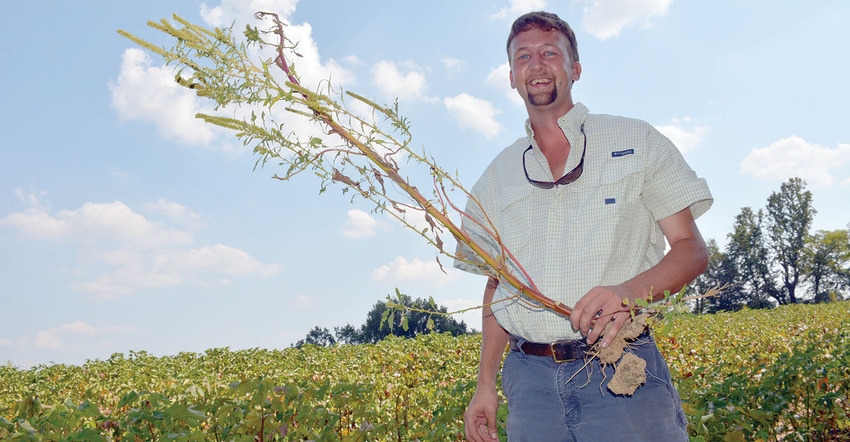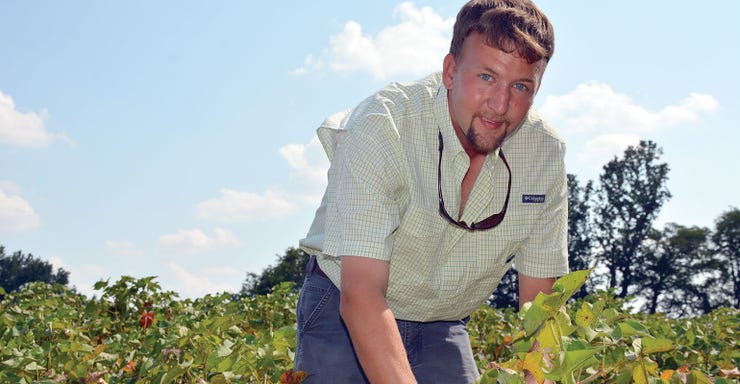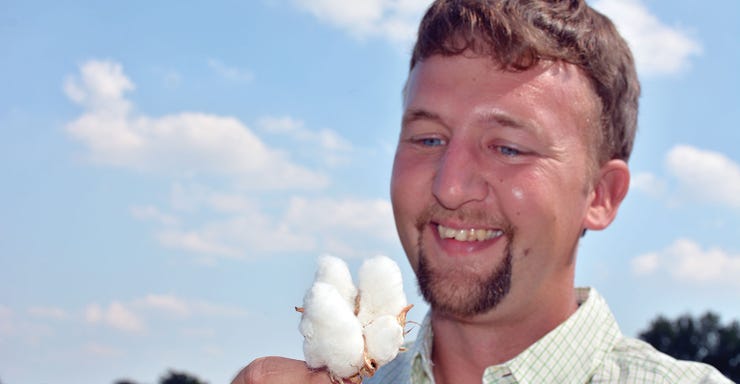
Andy Zarecor, 30, says dealing with a too-wet spring, a too-dry late summer and a trade war that persists too long challenges profitability on the cotton, corn and soybean farm he works with his father, Mack, near Yorkville, Tenn.
The Zarecors employ several production and management practices to improve their odds. Cover crops and cattle, rotation, and no-till play important roles in managing weeds, spreading risk and building organic matter.
A rainy planting season left the Zarecors about 400 acres short of the 1,000 acres of cotton they wanted to plant. They took prevented planting insurance on part of that acreage and seeded a summer cover crop mix, and they hope to see advantages with pigweed control and soil organic matter. They planted soybeans on some of that rained-out cotton land.
“We planted a mix of Sudan, millet and cowpeas on the prevented planting acres,” Zarecor says. “We hope next year to see some recycled nutrients and organic matter from the cover crop. We get an immediate benefit with weed control.”
He says without a cover, pigweed would take over fallowed acres or force them to employ other control measures — herbicide application or tillage.

Andy Zarecor
Cover crop management
Cover crops have been part of their management strategy for years. “We have 100 mama cows,” Zarecor explains. “In the fall we sow wheat, ryegrass and clover and let the cattle graze over the winter. We move them to permanent pasture in spring and plant summer crops into the cover. We plant primarily no-till.”
He says the cover benefits the cows through late fall and winter. “We get some benefit from the manure and the cover crop.”
They also plant a cover crop mix of ryegrass, wheat, crimson clover and vetch on land they don’t graze. “We’ve been planting that mix for five or six years. We’ve been using the grazing mix for cows longer than that.
“We sow cover as soon after harvest as possible.” He says they want to get grazing acres in early enough to provide forage for the cattle.
“We plant some by air before harvest,” he adds. “Germination varies, depending on rainfall. We’ve been 22 days without rain [on Sept. 18] and without a good chance of rain in the immediate forecast. I am not comfortable flying on a cover crop without a good chance of rain.”
He says winter pea germination is not as good by air as are the other species. “Clover and vetch come right along.”
He says the cover crop system allows them to grow cotton, corn or soybeans on land that might not be tillable otherwise. “We have a lot of rolling hills,” he says. “It would be hard to cultivate that land without the cover crop.”

Open Boll
NRCS assistance
He credits the Natural Resource Conservation Service (NRCS) for assistance in including cover crops in their production system. “We use NRCS Environmental Quality Incentives Program (EQIP) cost share funds on some of the cover crop acres. Working with our district conservationists and having an opportunity to use that cost share is part of what led us to begin using cover crops. We still have some acres in that program as well as several acres of cover we plant on our own, now that we have seen the benefits.”
Zarecor says he can’t claim with 100 percent certainty that the cover crop improves production. “We’ve made good yields behind cover crops, but we have been blessed for the past few years and made good yields on a lot of acres.”
Sustainability advantage
Conservation remains a big plus with cover crops. “It helps on a lot of cotton acres,” Zarecor says. “If the cover gets big, we roll it down just before planting and we see some weed suppression. But we do have a trade-off with limiting early pre-emergence herbicide application. Some can plant later and make it work with a cover crop system.
“Plus, we save topsoil. We have a limited amount of topsoil and we do all we can to keep it. If we get a big rain on acreage with no cover crop, we see topsoil heading down the Mississippi and we don’t get it back.”
A three-way rotation — one third each for cotton, corn and soybeans — also aids soil management. “We try to divide acreage evenly, but we would have had more cotton this year if not for prevented planting.”
Marketing is tough
Production offers such challenges every year, Zarecor says. “But the hardest part is marketing, especially with the ongoing trade tensions. We hope a trade deal is coming, but we just have to hold on until it gets here.”
He says the cotton market has “lost every bit of 15 cents a pound over the last year. Corn made a little rally and we had a good opportunity to sell at $4 or higher just after the Midwest floods.”
He says soybeans have not rallied but planting seed beans offers opportunities. “We have a unique position with 80 percent of our soybean acreage in seed production,” he says. “That option offers a better market with an opportunity for premiums.”
Weeds pose another expensive challenge. “And it is not an area where we can afford to cut costs. We will pay down the road. The cover crop helps with weed control on cotton acres.”
He says maintaining cotton yield is critical in a depressed market. “We’ve been averaging 1,000 to 1,100 pounds per acre, and we’ve seen some 1,200-pound yields the last few years. Overall average is around 1,000 pounds, dryland and irrigated. Irrigated acreage has ranged from 1,300 to 1,500 pounds.”
He says good varieties have helped maintain those yields. “We’ve planted mostly PhytoGen with the Enlist trait the last few years. We are pleased with it. We had a learning curve with Enlist, but we figured it out with the first few crops. In year three, we are happy with it.”

Heavy Cover
System approach with weeds
They don’t depend on one product. “We start with a pre and use residuals. We use Enlist Duo (with Roundup included) and we still apply quite a bit of Liberty.”
He says consistent rotation also aids weed management. “Behind a cover crop, we might plant cotton a second year, but we try not to stay with continuous cotton for too long.”
They double-crop some beans behind wheat. “Most soybeans will be double-cropped,” he says. “We try to stay as flexible as possible.”
Cover crops and cattle, no-till and rotation give the Zaecors options. Producing soybeans for seed adds a market advantage, and the cattle offer another risk management enterprise, which provides at least a little comfort with troubling markets.
About the Author(s)
You May Also Like






